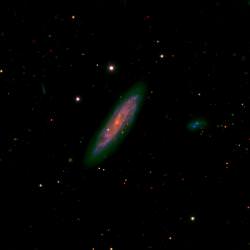

First light is a big deal. That’s when a new observatory opens up for the first time and gathers light on its detectors. It’s even a bigger deal when the world’s most powerful telescope sees the night sky for the first time. Astronomers get ready for the Large Binocular Telescope.
I’ve been writing stories about the LBT for years now, so it seems a little surreal to be reporting on its first light. But here we are. So, for those of you who haven’t been obsessing about this monster since it was first conceived, here’s the breakdown.
The Large Binocular Telescope, in case you hadn’t guessed, is actually two 8.4-metre telescopes perched side-by-side. Although they’re separate, they work together to act like a single, much larger telescope. They have the light-collecting power of an 11.8-metre telescope, and their combined light produces an image sharpness of a single 22.8-metre scope.
The first light images for the LBT were captured in January, and show the galaxy NGC 2770, located 102 million light-years away. The same scene was captured in ultraviolet and green light to show the regions of active star formation. And then it was captured again in red to show the older, cooler stars. Finally, a third composite image was put together that shows both features at the same time.
Now for a bit of history. The observatory’s structure was moved up to the top of Arizona’s Mount Graham in 2002. The first mirror was delivered in 2003, and aligned in 2004. The second mirror was delivered in 2005, and the first individual images where captured soon after that. But it wasn’t until this year that both halves were brought together to act as a single large observatory.
The first light is a great step. I can’t wait for the discoveries to pour in.
Original Source: University of Arizona News Release
Let’s dive into one of those cosmic curiosities that's bound to blow your mind: how…
The majority of the universe remains unmapped, but we have a potential window into it…
NASA engineers are pressing ahead with preparations for the Artemis II mission unless someone tells…
It’s not uncommon for space missions to be tested here on planet Earth. With the…
Some of our Solar System's moons have become very enticing targets in the search for…
Gateway’s HALO module heads to the U.S., on its long path to orbiting the Moon.…